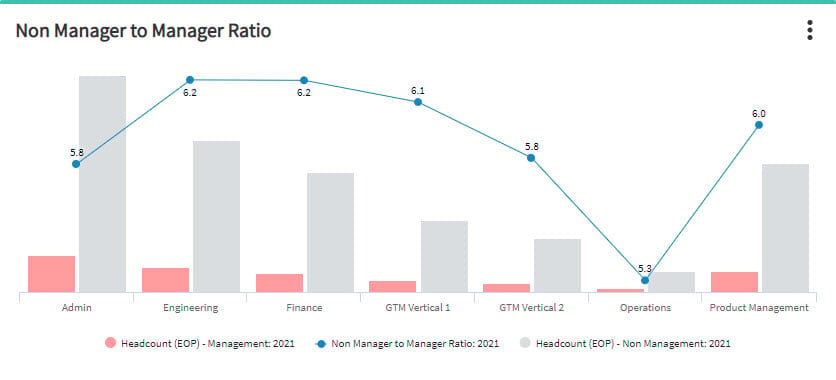In organizational management, span of control plays a key role in defining how streamlined and agile a company can be.
Understanding the Span of Your Manager-to-Employee Relationships
At its core, span of control refers to how many people a manager or supervisor directly oversees. The optimal number depends on a variety of factors including job type and job level, and most organizations set targets using rules of thumb and experience. The span of control metric helps determine if the organization is structured appropriately, with too large a span of control leading to ineffective management and manager burnout, and too small a span of control leading to inefficiency.
To calculate your average span of control, divide the total number of direct reports by the total number of supervisors. For instance, if there are 100 direct reports to 10 supervisors, the average span of control is 10.
Exploring the 2 Types of Span of Control
In the context of organizational structure, span of control is classified as either wide or narrow. Each type presents unique advantages and challenges, so it is not a one-size-fits-all proposition. The choice between a wide and narrow span of control depends on various factors, including:
- The nature of the organization's work and its structural preferences
- Industry norms
- Complexity of tasks
- Managerial capacity
- Job level
Both wide and narrow spans have their place, even across departments and job levels within an organization. The key is to find a balance that maximizes efficiency, promotes effective management, and aligns with the organization's overall goals.
Wide Span of Control

In a wide span of control, a single manager supervises many subordinates. This structure is often seen in companies with flat organizational structures, with fewer layers between the top and bottom levels and a shorter chain of command. Wide structures are also more common at lower levels in organizations.
Features:
- Low supervision overhead costs
- Prompt response from employees
- Improved coordination
- Suitable for repetitive or low-skill tasks
Advantages:
- Encourages delegation of authority
- Facilitates better manager development
- Ensures clear policies
- Promotes autonomy among subordinates
- Fewer levels in the managerial structure
- Cost-effective
- Suitable for larger firms and repetitive tasks
- Well-trained subordinates
Disadvantages:
- Risk of supervisors being overburdened
- Potential loss of control for superiors
- Need for highly qualified managing employees
- Hindered decision-making
- Increased workload for managers
- Unclear duties for team members
- Confusion among subordinates
- Management challenges in large teams
- Reduce manager-employee interactions
Narrow Span of Control

Conversely, a narrow span of control is characterized by a manager overseeing a smaller number of subordinates. This approach is prevalent at the top or middle management levels, especially when tasks are complex and require more support from superiors.
Features:
- Ideal for new managers to gain supervisory experience
- Beneficial for managing remote or diverse teams
- Necessary for jobs requiring frequent manager-employee interactions
- Useful in new operations and for employee training
Advantages:
- Easier communication and management in small teams
- High specialization and labor division
- Better opportunities for staff advancement
- Direct supervision by managers over each subordinate
- Effective communication between subordinates and managers
- More layers in the management structure for easier control
- Improved management control and effective supervision
Disadvantages:
- The potential of stifling of employees' creativity due to excessive manager control
- Slower decision-making in extended hierarchies
- Limited cross-functional problem-solving
- Higher costs due to more managerial positions
- Delays in information transmission and decision-making
The Challenge of Manual Span Management
Effective span management is a balancing act, nearly impossible to achieve without technology. Strong span management requires examining spans vertically, horizontally, and over time; this creates a complex situation that is not easily or effectively handled without well-orchestrated data.
Span Management Impacts
A high manager-to-employee ratio might lead to insufficient attention to each team member, potentially affecting employee development and performance. Conversely, a low ratio could indicate inefficiencies and a bloated organizational structure that erodes profitability.
Span Management in Different Industries
Span management requires a tailored approach, as the ideal ratio varies by industry and job function. In labor-intensive industries, a higher ratio is often more manageable, whereas in knowledge-based sectors, a lower ratio might be preferable to ensure quality supervision and mentorship.
Seasonal Staffing
Certain industries or departments may experience fluctuations in workload at different times of the year, necessitating a flexible approach to span management. During peak seasons, managers may need to handle more direct reports or delegate responsibilities more effectively, while in slower periods, they may focus on training and development. A dynamic strategy can maintain efficiency without compromising the quality of supervision or employee growth.
The Role of HR and Analytics in Span of Control
Human Resources plays a critical role in monitoring and adjusting the span of control. HR can track this metric in real-time by using analytics tools to help maintain an optimal balance. People analytics software like One Model offers capabilities to analyze and adjust management span of control across various levels and departments, ensuring organizational efficiency and employee satisfaction.
Data-Driven Span of Control Analysis
Span of control analyses help organizations identify optimal structures and make precise staffing decisions in response to changes over time. Using people analytics tools, HR can dissect span of control across different dimensions such as department, geography, and manager level.
Analysts should examine span of control:
- Both vertically and horizontally, and over time
- Relative to gross and net revenue
- Relative to employee-related outcomes such as engagement and retention
It is not practical or effective to evaluate and manage span of control manually; this is an area where robust data can be used to drive effective decision making and optimize outcomes.

However, to kickstart this analysis, even basic data from a core HCM or HRIS system can be enlightening. Metrics like span of control and organizational layers are akin to stepping on a scale — they provide immediate feedback on the state of your organizational structure.
Within this discussion, key metrics such as span of control trends and visualization of layers and organizational units are invaluable. One crucial metric, for instance, is the number of managers with only one or two direct reports. This simple statistic can reveal much about the nature of your management structure.

These insights are essential for keeping talent management processes aligned with business reality. If your current team or technology cannot readily provide these views, it may be time to reconsider your approach and tools.
It took our team under 5 minutes to find the ratio between managers and non-managers.
How long will it take your team to answer Question #38 on the People Analytics Challenge?
Setting Targets for Span of Control
Setting the right targets for span of control involves considering various factors, including industry norms, organizational structure, and management levels. A higher ratio may be effective for frontline or production roles, while senior management might require a lower ratio to strategize and lead effectively.
Organizations often set their span of control targets based on industry benchmarks, aiming for a median that balances efficiency and managerial attention. Variations in span of control targets can be set for different organizational units, such as contact centers, corporate offices, and field operations. But the best organizations strive to surpass industry norms and link span of control metrics with outcomes of interest such as efficiency, profitability, employee engagement, and voluntary turnover. By doing so, they can optimize span of control to drive desired outcomes.
Mastering Span of Control with One Model
Understanding and effectively managing the span of control is crucial for any organization seeking to optimize its structure for maximum efficiency and employee development.
With One Model, organizations can gain the insights needed to make informed decisions about their management structures, ensuring they are well-equipped to adapt to changing market demands and internal growth dynamics. One Model also supports next-level span-of-control analytics by allowing organizations to link span-of-control with operational metrics, moving the organization from descriptive analytics into the realm of optimization. After all, blindly following industry benchmarks won't ensure optimization within the organization.
One Model is equipped to support optimization through the modeling core HRIS data, employee engagement data, employee performance data, and operational data related to production, safety, and financial outcomes. If you aren’t using a tool to measure and track span of control, you’re missing out. If you aren’t linking span of control to business metrics that matter, you’re really missing out.



